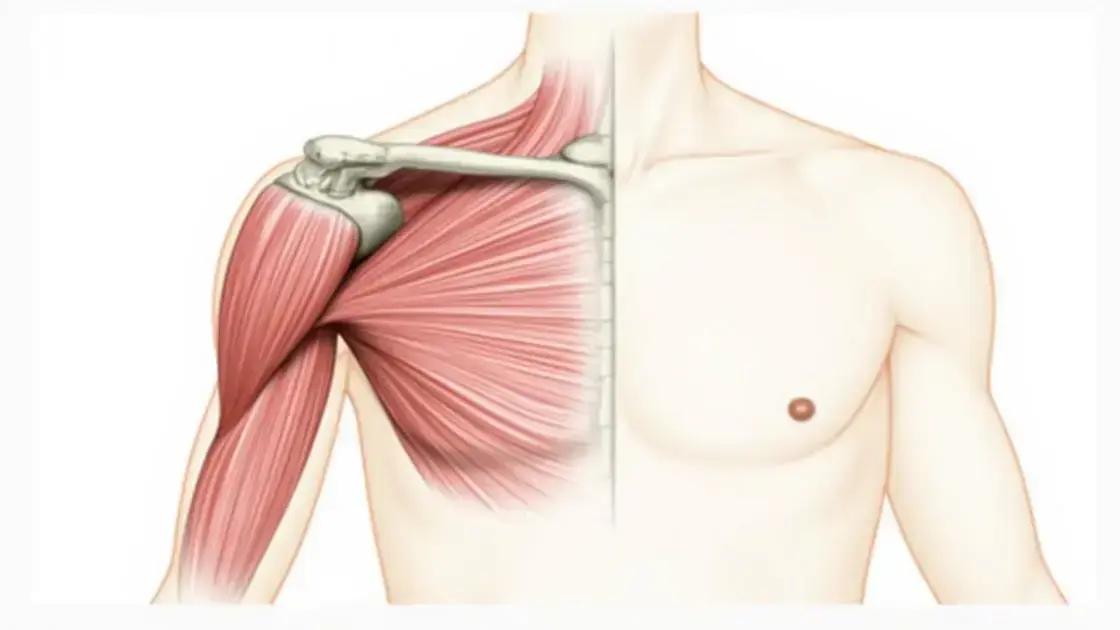To strengthen shoulders without strain, focus on effective exercises like wall angels and resistance band external rotations, while ensuring proper form, warming up, and incorporating rest days for injury prevention.
Have you ever wondered how to strengthen shoulders without strain? Strong shoulders are crucial for stability and overall performance in various activities. Whether you’re an athlete looking to improve your game or someone who wants better posture, it’s essential to focus on proper techniques to avoid injury. In this article, we will delve into understanding shoulder anatomy, explore the benefits of strengthening these muscles, and share effective exercises to enhance shoulder strength safely. Join us as we uncover the best practices to achieve optimal shoulder health without unnecessary strain.
Understanding Shoulder Anatomy

Understanding the body’s shoulder anatomy is key to strengthening them effectively and safely. The shoulder is a complex joint, made up of several bones, muscles, and tendons. The main bones involved are the humerus, scapula, and clavicle. These bones work together to allow a wide range of motion.
Components of the Shoulder
The shoulder comprises several important components:
- Humerus: This is the upper arm bone that fits into the shoulder socket.
- Scapula: Also known as the shoulder blade, this bone connects to the upper arm and provides a base for muscle attachment.
- Clavicle: Commonly known as the collarbone, this bone links the arm to the body and helps stabilize the shoulder
Muscles Involved
Several muscles play vital roles in shoulder movement:
- Rotator Cuff: This group of four muscles helps stabilize the shoulder and allows for lifting and rotation.
- Deltoid: Located on the outer shoulder, this muscle enables arm movements like raising and lifting.
- Trapezius: This large muscle extends from the neck to the middle of the back and supports shoulder motion.
Understanding Mobility and Stability
The design of the shoulder allows for great mobility but can compromise stability. Strengthening the shoulder muscles can help protect this joint from injuries. It’s important to focus on building strength without straining the shoulder.
By learning about shoulder anatomy, you can more effectively implement exercises that strengthen the shoulder without causing strain. Understanding how these components work together helps in performing exercises correctly and safely, setting the stage for proper training techniques.
Benefits of Strengthening Shoulders

Strengthening your shoulders comes with many benefits. First, strong shoulders help improve posture. Good posture can reduce back and neck pain, making daily activities easier and more comfortable.
Enhanced Athletic Performance
For athletes, strengthening the shoulders can enhance performance. Strong shoulders facilitate better movement during sports such as swimming, baseball, and weightlifting. It allows for more powerful throwing, lifting, and swimming strokes.
Injury Prevention
Another significant benefit is injury prevention. Strengthening the shoulder muscles helps stabilize the joint. This stability reduces the risk of common injuries, such as dislocations and strains. When the muscles surrounding the shoulder are strong, they better protect the joint.
Improved Range of Motion
Strengthening shoulder muscles can also lead to an increased range of motion. This improvement can make everyday tasks easier, like reaching for items or lifting things overhead. A greater range of motion enables you to perform exercises more effectively.
Support for Daily Activities
Everyday activities, such as lifting groceries or carrying a backpack, require strong shoulders. When you have well-strengthened shoulders, even the simplest tasks become easier. They help you maintain functionality throughout your life.
Effective Shoulder Exercises Without Strain

Here are some effective shoulder exercises designed to strengthen your shoulders without causing strain. These exercises focus on proper form and low-impact movements.
1. Wall Angels
Stand with your back against a wall, feet slightly away from it. Keep your arms at a 90-degree angle, touching the wall. Slowly raise your arms overhead, sliding them against the wall. Lower them back down to the starting position. Repeat 10-15 times.
2. Shoulder Blade Squeeze
Sit or stand with your arms at your sides. Squeeze your shoulder blades together, as if you’re trying to hold a pencil between them. Hold for 5 seconds, then release. Repeat 10-15 times. This exercise improves posture and strengthens the upper back.
3. Resistance Band External Rotation
Attach a resistance band to a stable surface at elbow height. Stand to the side of the band, gripping it with the hand farthest from the attachment point. Keeping your elbow bent at 90 degrees, pull the band away from your body while keeping your elbow close to your side. Return to the starting position. Repeat 10-15 times on each side.
4. Dumbbell Lateral Raises
Stand with a dumbbell in each hand at your sides. Raise your arms out to the sides until they are parallel to the ground. Keep a slight bend in your elbows. Slowly lower your arms back down. Aim for 10-15 repetitions. If you’re new to this exercise, use light weights to avoid strain.
These exercises can be performed 2-3 times a week for best results. Always listen to your body and adjust as needed to prevent discomfort.
Safety Tips for Shoulder Workouts

When performing shoulder workouts, following safety tips is essential to prevent injuries and ensure effective training. Here are some key guidelines:
1. Warm Up Properly
Always start with a warm-up to prepare your body for exercise. Perform dynamic stretching and light cardio for at least 5-10 minutes. This helps increase blood flow to your muscles and reduces injury risk.
2. Use Proper Form
Maintain correct form during exercises. Poor posture can lead to strain on your shoulders. Focus on alignment and technique. If unsure, consider working with a trainer or using mirrors to maintain proper posture.
3. Start with Light Weights
If you are new to shoulder workouts, begin with light weights. Gradually increase the weight as you build strength and confidence. Avoid lifting heavy weights too soon to prevent strain or injury.
4. Listen to Your Body
Pay attention to how your shoulders feel during workouts. If you experience pain or discomfort, stop the exercise immediately. Pushing through pain can lead to serious injuries. Modify the exercise or choose a different one if needed.
5. Incorporate Rest Days
Allow your muscles to recover by incorporating rest days into your routine. Rest is essential for muscle repair and growth. Overtraining can lead to fatigue and increase injury risk.
6. Stay Hydrated
Drink plenty of water before, during, and after your workout. Staying hydrated helps maintain performance and supports recovery. Dehydration can lead to muscle cramps and fatigue.
Following these safety tips will help you enjoy effective and safe shoulder workouts, leading to better results without unnecessary strain.
Strengthen Shoulders Without Strain
Strengthening your shoulders is essential for both athletic performance and daily activities. By understanding shoulder anatomy, you can target the right muscles and engage in effective exercises.
Incorporating safe training practices ensures that you benefit from these workouts without the risk of injury. Remember to warm up properly, maintain good form, and listen to your body. These steps not only enhance your strength but also contribute to long-term shoulder health.
By following the tips discussed in this article, you can achieve a stronger and healthier shoulder routine that supports all aspects of your life.
FAQ – Frequently Asked Questions About Strengthening Shoulders
What are the benefits of strengthening my shoulders?
Strengthening your shoulders can improve posture, enhance athletic performance, prevent injuries, and support daily activities.
How can I safely perform shoulder exercises?
To perform shoulder exercises safely, always warm up, use proper form, start with light weights, and listen to your body’s signals.
What exercises can help strengthen my shoulders without strain?
Effective exercises include wall angels, shoulder blade squeezes, resistance band external rotations, and dumbbell lateral raises.
How often should I do shoulder workouts?
Aim to perform shoulder workouts 2-3 times a week, allowing time for recovery between sessions to avoid overtraining.
What should I do if I feel pain during shoulder exercises?
If you experience pain during exercises, stop immediately. Modify the exercise or consult a fitness professional for proper guidance.
How important is it to stay hydrated during workouts?
Staying hydrated is crucial as it helps maintain performance, supports recovery, and reduces the risk of muscle cramps.













